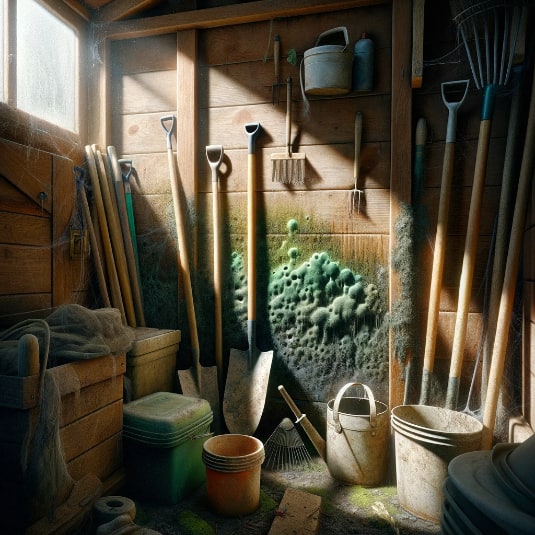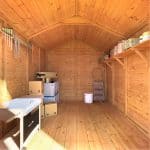Jump to:
To damp proof a shed means stopping moisture from damaging the building’s lifespan. While this may seem daunting, it can be manageable with the proper guidance. Here, we explore methods to get rid of dampness, addressing issues like mould and mildew.
How Do I Prevent Mould in My Garden Shed?

The secret is simple: air it out. With no fresh air flow, stagnant air just sits in your shed. This air holds moisture and can condense on walls and windows. Boom — now you have mould and mildew in your storage building. Practice shed ventilation to allow fresh air circulation in the interior. Simply open the windows or install vents, skylights, or whirligigs on the shed’s roof.
It’s also smart to avoid storing damp items like fabric and wooden furniture. Clothing and lines are prone to absorbing moisture. They can become mouldy and musty and develop stains and unpleasant odours. Wood is particularly sensitive to fluctuations in humidity, too. It can be susceptible to swelling, warping, and even rotting. Moisture can also attract pests like termites, further damaging the furniture.
Interior treatment shouldn’t be necessary if you’ve invested in a pressure treated shed. Otherwise, consider these alternative methods to keep the inside dry and damp-free:
- Gap sealing: Sealing gaps in your garden storage shed helps prevent moisture intrusion. Use a silicone caulk gun or expanding foam to seal off any openings around windows, doors, or the base. Draught excluders help block air entry while expanding foam fills window gaps. Together, these create a barrier that keeps moisture out.
- Gutter installation: Guttering manages water run-off, stopping moisture from seeping through the roof. It can direct rainwater away from the shed’s foundation when properly installed. This can reduce the likelihood of water pooling around the structure.
- Vapour membrane: Install a vapour membrane between the shed’s framing. This can act as a barrier against moisture and helps maintain a dry environment. Read our guide on shed insulation for more information.
- Hygrometer and dehumidifier: Monitor humidity levels with these essential items. A hygrometer provides insight into the moisture content of the air. Pairing it with a dehumidifier enables you to control and reduce excess moisture. A dehumidifier extracts moisture, creating a drier environment that inhibits mould and mildew.
How Do I Treat Mould Effectively?
Treating your shed’s mould is crucial to maintaining a safe and healthy environment. Even if mould has already appeared, it’s never too late to take action. Here are simple steps to effectively tackle the growth and prevent its recurrence.
1. Clear out and inspect
Start by removing all items from your shed. Use this opportunity to inspect furniture and tools for signs of dampness and mould. This helps identify and address any hidden sources of moisture contributing to mould.
2. Check for leaks
Inspect your shed base for spills and examine the roof and walls for leaks. Addressing these sources of moisture intrusion is essential to prevent mould from reoccurring. Fix any leaks promptly to eliminate the conditions that foster mould growth.
3. Bleach solution treatment
Prepare a diluted bleach solution (1 part bleach to 4-10 parts water) in a spray bottle. Wear gloves and old clothes for protection. Open shed doors and windows for ventilation, then spray the affected areas. Use a sponge to scrub away mould stains and spores effectively.
4. Allow for ventilation
After treating the mould, leave your shed to air out for a full day if possible. Proper ventilation helps dry out the treated areas and prevent moisture buildup.
5. Apply shed treatment
Apply a shed treatment and pesticide to the exterior timber of your shed. This helps protect the wood from moisture damage and prevents pest infestations. Follow the product instructions carefully for optimal results.
6. Respray vinegar
After the initial treatment, respray affected areas with a diluted vinegar solution. Vinegar is a natural fungicide that effectively kills mould and prevents its return. You can add a fragrance to the vinegar spray to mitigate its strong odour.
7. Optional measures
Consider leaving open containers of baking soda or using a dehumidifier in your shed. Baking soda helps absorb excess moisture and neutralise odours. Meanwhile, a dehumidifier helps maintain optimal humidity levels, inhibiting mould growth.
Round-up
Keeping your shed dry and free from mould and mildew is important for making it last longer. By following the steps we discussed, you can stop moisture from causing damage. Understanding why dampness happens and what it can do to your shed also helps you take the right actions. With a little effort, you can ensure your garden building stays strong and sturdy for a long time.
When it’s time for a new investment, check out our garden sheds for sale. Or visit Garden Buildings Direct for a wide range of options.
Next on your reading list: How to Insulate a Garden Shed (A Mega Guide)
If you have any further questions, contact us and don’t hesitate to give us a call at 01909 768840.
Shop The Master Apex Shed









